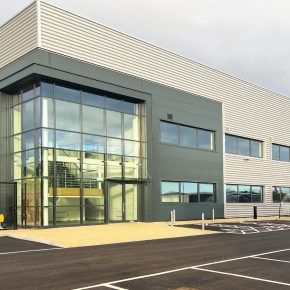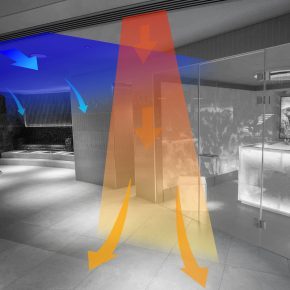
Data is critical to your business, so physical security for servers is more important than ever – ASSA ABLOY
When imagining a corporate data breach, visions of black-hat wearing hackers being pursued by cybercrime investigators may come to mind. The reality is often more mundane, as ASSA ABLOY explain…
Roughly a half of breaches involve hacking, according to one recent report*. Gaps in the physical security your data and servers are equally important targets.
Perhaps your company director leaves her laptop on the train. Or an unauthorised visitor spots open server racks and quickly downloads records onto his smartphone. Or maybe your server room access control is left entirely to lock-and-key technology which you cannot easily track.
Securing sensitive data needs the involvement of every member in an organisation, from top to bottom. But physically protecting servers and data stores is the heart of the security and IT manager’s role.
How much could a data breach cost you?
In the absence of appropriate physical server security, the mundane can be dangerous — and expensive. Recent research for IBM by the Ponemon Institute estimates the average total cost of a data breach at $3.86 million (€3.57 million)**.
According to the same benchmark report, this average is rising, by 6.4% in the last year alone. Some of the highest breach costs are borne by companies in Europe, including Germany, France, Italy and the UK.
Such costs can be direct: in business disruption, lost mailing lists or disabled logistics software. They can be indirect: an erosion of customer trust and damaged “brand equity”. Hard-earned goodwill and positive reputations are quickly reversed.
Costs also come from fines levied by government and supranational regulators. As Big Data gets bigger, so does the regulatory landscape for data handling.
The most relevant framework for those operating in the EMEA region is the European Union’s General Data Protection Regulation (GDPR). This wide-ranging data privacy rulebook has been enforced since May 2018.
GDPR requires you to protect storage of all personal information, including customer and employee data. Your safeguards must include both electronic and physical barriers to unauthorised access. Server protection is critical.
Three levels of physical security for your servers
Do you know who last accessed your servers — and when? If the answer to either question is ‘no’, you are taking unnecessary risks with data security. Yet ensuring you stay on the regulators’ right side, and avoid a costly breach, could be straightforward: better access control.
To ensure maximum security of your servers, in its recent white paper ASSA ABLOY recommends three levels of security working together within an integrated access system.
At the top level, perimeter security ensures only authorised personnel enter a data storage building. Here, door and gate electronic locks with credential readers can work alongside the likes of CCTV and monitored fencing. It’s your first line of physical breach defence.
Level 2 — server room access — can be monitored and controlled with a range of access control door devices with inbuilt credential readers, including Aperio battery-powered escutcheons or complete security locks.
Either device integrates seamlessly with access and security management systems from over 100 different manufacturers. At room level, physical security must also include water- and dustproofing, electromagnetic security and protection against other physical threats to servers and data***.
The third, final level of physical data security is your server rack or cabinet. Server rooms have a steady flow of authorised traffic: cleaners, maintenance staff, repair technicians and others. Employee screening cannot be perfect — and accidents happen.
Rack or cabinet locking with RFID readers is the last line of defence against a malicious or accidental physical data breach.
Responsive, real-time rack protection
ASSA ABLOY’s Aperio KS100 Server Cabinet Lock adds real-time access control and monitoring to server racks and cabinets. The lock works with an existing or new access control system; compatible credentials employ all standard RFID protocols including iCLASS®, MIFARE® and DESFire.
Under the EU’s GDPR, you must inform anyone affected by a breach “without undue delay”. With the Aperio KS100, you would know right away if unauthorised access had even been attempted.
Once installed, KS100 locks integrate with your access control system and communicate wirelessly via an Aperio Communications Hub, even if your racks are co-located in a distant data centre.
Once online integration with your security admin system is complete, lock access decisions are communicated from and recorded by your software wirelessly.
Johan Olsén, Aperio Product Manager at ASSA ABLOY Opening Solutions EMEA, commented: “When Aperio replaces mechanical locking at all three levels of server access control, lost keys no longer compromise data security. Lost credentials are simply deauthorised and a valid replacement reissued.
“The current status of any lock, at any level, is revealed with the click of a mouse. Generating detailed audit trails is straightforward, making the KS100 and other Aperio wireless locks invaluable for incident investigation.”
The right electronic locking keeps your customer reputation intact, your data off the Dark Web, and you on the right side of the multiple data protection regulations, including GDPR.
Could you protect your valuable data better with improved access control? Download ASSA ABLOY’s free 12-page briefing paper on data centre security at https://campaigns.assaabloyopeningsolutions.eu/aperio-data-centers
Sources
*: https://enterprise.verizon.com/resources/reports/dbir/
**: Ponemon Institute/IBM, “2018 Cost of a Data Breach Study: Global Overview”
***: https://www.git-security.com/file/track/22687/1
Contact ASSA ABLOY Opening Solutions EMEA Digital and Access Solutions
Dukes Court/Dukes Street
Woking
GU21 5BH
United Kingdom
Web: About us | ASSA ABLOY
Email: Thomas.schulz@assaabloy.com
Phone: 0049 30 8106 2970
Visit Supplier's page
Latest news

2nd April 2025
FIT Show 2025 Launches Innovative Marketplace Feature to Enhancing Value for Installers
FIT Show, the UK’s leading event for the window, door, flat glass, hardware, and roofing industries, is excited to announce the launch of a brand new Marketplace feature at its upcoming 2025 event (Birmingham NEC, 29 April – 1 May).
Posted in Architectural Ironmongery, Articles, Building Industry Events, Building Industry News, Building Products & Structures, Doors, Exhibitions and Conferences, Glass, Glazing, Hand Tools, Innovations & New Products, Plant, Equipment and Hire, Power Tools, Restoration & Refurbishment, Retrofit & Renovation, Roofs, Seminars, Training, Windows
2nd April 2025
Hi-spec deployment of EJOT Colorfast at new Birmingham logistics park
EJOT Colorfast fasteners have been used extensively in the construction of eight new high-specification warehousing and logistics buildings at the Urban 8 Logistics Park in King’s Norton, Birmingham.
Posted in Articles, Building Industry News, Building Products & Structures, Building Systems, Case Studies, Facades, Restoration & Refurbishment, Retrofit & Renovation, Roofs, Walls
2nd April 2025
SWA member delivers ‘fresh Hope’ for university’s Sustainable Building department
A detailed contract to restore an iconic Art Deco building in the heart of Birmingham’s Jewellery Quarter was carried out by Steel Window Association member, The Window Repair Company (Northwest) Limited.
Posted in Articles, Building Associations & Institutes, Building Industry News, Building Products & Structures, Building Systems, Case Studies, Glass, Glazing, Restoration & Refurbishment, Retrofit & Renovation, Steel and Structural Frames, Sustainability & Energy Efficiency, Windows
1st April 2025
Gilberts Takes Thermal Comfort to New Heights
Gilberts Blackpool is continuing to build on its reputation as a pioneer with the unveiling of ThermaAstute™ – the most extensive range of thermally sensitive diffusers in the market.
Posted in Air Conditioning, Articles, Building Industry News, Building Products & Structures, Building Services, Facility Management & Building Services, Heating, Ventilation and Air Conditioning - HVAC, Innovations & New Products, Restoration & Refurbishment, Retrofit & Renovation, Sustainability & Energy Efficiency
 Sign up:
Sign up: